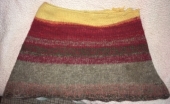Exciting! Per oz, Buffalo and Musk ox fibre (wool, technically comes from sheep only, but there is a time when the word was used to refer to 'yarn' in advertising to get people used to synthetic fibres) is one of the most expensive textile fibres in the world! It is soft, it is warm, it is beautiful.
I don't know anyone that raises them for the fibre alone. Most raise for the meat, then they process the fibre as extra income. My understanding is that per animal, the amount of fibre is pretty small and that it is mostly harvested after the animal is killed for meat. It takes a lot of labour to sort the fibre as it comes with the guard hairs. Because it's so expensive, people expect the highest quality, which isn't easy to produce. It might be worth contacting someone who grows the fibre to see exactly what's involved. It's really neat if you can get it, but I recommend gathering as much information as you can before committing to it, as I've seen more than a few people falter from lack of understanding just what's involved. These guys might be a good starting point
https://www.arcticqiviut.com/
If you don't spin yet, your first step is to learn how. This will give you a massive advantage over some other fibre farmers as you can learn exactly what makes a quality fibre. Diet, environment, and many other factors all combine to affect the quality of the fibre. Being able to tell which needs tweaking makes one fibre farmer stand out from the rest.





 2
2




 1
1




















































